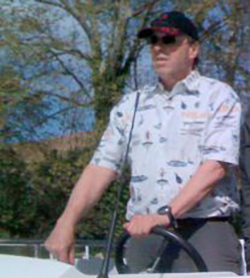THE DYSFERLINOPATHY JOURNEY
Individual Stories
THE DYSFERLINOPATHY JOURNEY
Individual Stories
Home ❯ Patients/Clinicians ❯ The Dysferlinopathy Journey ❯ Individual Stories ❯ Marlen
Marlen

I have led an active life and enjoyed many sports beginning in high school where I played on the basketball, track, baseball, and swim teams. In my twenties and thirties I was active in outdoor sports including serious rock, ice and mountain climbing and I continue to play tennis and golf today. After retiring in 1988 at age 50, I settled on an 80 acre farm where I raise cattle, sheep and cashmere goats and put up over 30 tons of hay a year. It was a lot of hard work, but I had no sense of limitations.
In the early 1990’s I began to have symptoms of loss of mobility and soreness in my back and hips and it was getting harder to carry heavy things directly in front of me, which initially I ascribed to normal wear and tear of farm life. Prior to this I had had no major indications of disability. At this point I began investigating what might be amiss.
My regular internist had no clue about my back complaints and recommended me to a neurologist who electrically tested nerve paths (a process which reminded me of my high school biology experiments with the frog legs) and finally, after I had passed these, he wanted to do a spinal tap to rule out any possibility of ALS and other neurological problems, which I declined (such a big needle). I then saw an orthopedic surgeon who wanted to perform back surgery on my damaged discs which showed up on MRIs. After his description of how he proposed going in from the front and rearranging all my organs first on the table and then back in me if they all still fit, I declined his offer. I tried an acupuncturist who thought my che was on the blink and needled me with no results and offered some evil-smelling herbs to swallow. I passed on these as well. Next came the electro stimulation which consisted of being wired up and zapped, but when I leaped up from the electrocution with my hair standing straight up, and he was mumbling about how hard it was to get this new-fangled equipment to work right, I opted for no mas.
I tried a chiropractor who was convinced I was just out of alignment and tried straightening me out and offered a lengthy program of bone-crunching visits. I gave these up when it was evident it was doing no good. I then tried a neurosurgeon who first gave me some cortisone shots which helped mostly when he stopped, but the effects only lasted for a few hours. So then I finally gave in and agreed to an L5-S1 discectomy. Although it was a fun experience (thanks to the drugs), remarkably, it did not help my condition. My doctor finally concluded it was just old age and get on with it.
In 1998 I had moved to Portland and my new internist ran some blood tests for cholesterol and included, by chance it seems, a CK check. I got a call a few days later from him being totally mystified and rattled. “Your CK level is 4500 and I have no idea what it means; should be under 100. Go see a neurologist, quick.” I did, and after an exam, he sent me to get a muscle biopsy and we started getting somewhere at last. The results came back — no dysferlin.
OHSU then took over and ran about a million tests and confirmed the results and, after over ten years of tests and many specialists, a diagnosis of LGMD2B was confirmed. I was told, very firmly, that I was not to exercise much at all since this condition would not allow my muscles to recover and it would speed the inevitable process of muscle wasting. My prognosis was for a steady physical decline but it was not fatal. I promptly gained 15 pounds and felt lousy.
We moved to Bellevue and I connected with the University of Washington and, by very good fortune, the Jain Foundation. U of W ran me through a bunch of tests and recommended an exercise program (which I have greatly expanded) and over the last year have regained some of my strength. I can walk over a mile and play tennis and hit a golf ball again (not all at the same time, of course). The Jain Foundation kindly sponsored my DNA test with Dr. Levy in France.
My limitations are fairly standard. Although I can walk (slowly) extended distances, I cannot run more than a few steps. I cannot lift much in front of me without bending over. Stairs are tough. I take Ibuprofen for the muscle aches and pains, and it works well. I need to sit rather than stand, although extended sitting (long car trips, etc.) is not good. I have sporadic muscle spasms when I am asleep. I tire significantly from tennis or my exercises, but after a rest I can get around again. It takes an extra day between tennis or other exercises. However, I am convinced something is acting in place of dysferlin to allow my muscles to recover, albeit much more slowly than normal.
I would like to thank the Jain Foundation for their efforts in support of the research for a cure for MD, and for extending an invitation to my wife and me to attend their conferences.
